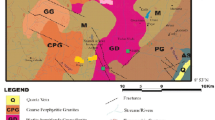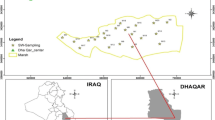Abstract
The activity level of natural uranium pollutant in surface-based water around Princess Gold Mine in Roodepoort, South Africa was measured using inductively coupled plasma mass spectrometry. The highest activity level of 6.39E+04 mBq/L is reported in the reddish brown ochre surface water from tailing (SWA-RB) close to the houses, whereas the lowest value of 1.92E+03 mBq/L is reported in the flowing surface water (SRWA-5) 1 km away from the dump. Along the path high values of 1.56E+04, 1.07E+04, 1.57E+04 and 8.46E+03 mBq/L were reported at SRWA-2, SRWA-3 and SRWA-4, respectively. The inhabitants living around the tailings use the surface water for daily consumption. Based on the annual limit guideline for drinking water recommended by World Health Organization (731 L/year), this study revealed that, the community around this vicinity receives 2.10 mSv as the highest annual collective effective dose due to 238U in the drinking surface water. The radiological-health risks of 238U in the water samples analysed revealed the highest cancer mortality and morbidity values of 2.40E+03 and 3.67E+03, respectively. The mean chemical toxicity risk for the natural uranium over the lifetime consumption is 5.31E+05 μg/kg/day which shows that the main human risk may likely be due to the chemical toxicity of natural uranium.





Similar content being viewed by others
References
Amakom CM, Jibiri NN (2010) Chemical and radiological risk assessment of uranium in borehole and well waters in the Odeda Area, Ogun State, Nigeria. Int J Phys Sci 5(7):1009–1014
Bhatt KB, Saklani S (1996) Hydro-geochemistry of the upper Ganges river. J Geol Soc India 3(48):171–182
Bleise A, Danesi PR, Burkart W (2003) Properties use and health effects of depleted uranium (DU): a general overview. J Environ Radiol 64(2–3):93–112
Council Directive 98/83/EY/ (1996) On the quality of water intended for human consumption. Off J Eur Commun L330:32–54
Department of Water Affairs and Forestry (DWAF) (2004) Free state region river systems: 2003. State of Rivers Report 6. Accessed March 2004
Internal Commission on Radiological Protection (1993) Age-dependent doses to members of the public from intake of radionuclides. Part 2: ingestion dose coefficients. Pergamon Press, Oxford (Annals on the ICRP. ICRP publication 67)
Internal Commission on Radiological Protection (1995) Age-dependent doses to members of the public from intake of radionuclides, Part 3: ingestion dose coefficients. Pergamon Press, Oxford (Annals of the ICRP, ICRP publication 69)
Kurttio P, Auvinen A, Salonen L, Saha H, Pekkanen J, Makelainen I, Komulainen H (2002) Renal effects of uranium in drinking water. Environ Health Perspect 110(4):337–342
Kurttio P, Komulainen H, Leino A, Salonen L, Auvinen A, Saha H (2005) Bone as a possible target of chemical toxicity of natural uranium in drinking water. Environ Health Perspect 113(1):68–72
McMillan H, Krueger T, Freer J (2012) Benchmarking observational uncertainties for hydrology: rainfall, river discharge and water quality. Hydrol Process 26:4078–4111
Nisi B, Buccianti A, Vaselli O, Perini G, Tassi F, Minissale A (2008) Hydro-geochemistry and strontium isotopes in the Arno river basin (Tuscany, Italy): constraints on natural controls by statistical modeling. J Hydrol 360:166–183
Reimann C, Banks D (2004) Setting action levels for drinking water: are we protecting our health or our economy (or our backs!)? Sci Tot Environ 332:13–21
Rodriguez MJ, Sanchez F (1995) Behavior of uranium along Jucar River (Eastern Spain): determination of 234U/238U and 235U/238U ratios. J Radioanal Nucl Chem 190:113–120
Schot PP, Van Der Wal J (1992) Human impact on regional groundwater composition through intervention in natural flow patterns and changes in land use. J Hydrol 134:297–313
Scott R (1995) Flooding of the central and east rand gold mines, an investigation into controls over the inflow rate, water quality and the predicted impacts of flooded mines. WRC Report No 486/1/95
SRK (2013) Final scoping report for the environmental impact assessment and environmental management programme for BHP Billiton Energy Coal South Africa (Pty) Ltd (BECSA)’s Vandyksdrift Central (VDDC) Project; BHP Billiton Energy Coal South Africa (Pty) Limited (BECSA). SRK Project Number 449019
SAMRC (2015) South African Medical Research Council (MRC); Rapid mortality surveillance report 2013, issued by the council’s Burden of Disease Research Unit; Media release, 27 January 2015. www.mrc.ac.za/bod/reports.htm
Tshivhase VM, Njinga RL, Mathuthu M, Dlamini TC (2015) Transfer rates of 238U and 232Th for E. globulus, A. mearnsii, H. filipendula and hazardous effects of the usage of medicinal plants from around gold mine dump Environs. Int J Environ Res Public Health 12:15782–15793
United Nations Scientific Committee on the Effects of Atomic Radiation, UNSCEAR (2000) Sources, effect and risks of ionising radiation. UNSCEAR, New York (Report to the General Assembly with Scientific Annexes)
United State Environmental Protection Agency, USEPA (1999) Cancer risk coefficients for environmental exposure to radionuclides. U.S. Environ. Protec. Agen. Feder. Guida. Repo. 13 (EPA. 402 R-99-001)
United State Environmental Protection Agency, USEPA (2000) Methodology for deriving ambient water quality criteria for the protection of human health. EPA-822-B-00-004, pp 2–3
World Health Organization (2003) Guidelines for drinking water quality health criteria and other supporting information, vol 2, 2nd edn. World Health Organization, Geneva, pp 367–370
World Health Organization (2004) Guidelines on drinking water quality, 3rd edn. World Health Organization, Geneva
World Health Organization (2006) Meeting the MDG drinking water and sanitation target: the urban and rural challenge of the decade. World Health Organization, New York, pp 1–47
Yeshin K, Hoasung P, Jinyong K, Sun-ku P, Byongwook C, Ighwan S, Dong Chun S (2004) Health risk assessment for uranium in Korean groundwater. J Environ Radioact 77:77–85
Acknowledgments
We gratefully acknowledge the financial support from the Council for Geoscience and the School of Agriculture science for providing the equipment used in this work.
Author information
Authors and Affiliations
Corresponding author
Rights and permissions
About this article
Cite this article
Njinga, R.L., Tshivhase, V.M. & Mathuthu, M. Chemical Toxicity of Surface-Based Drinking Water Sources Due to Natural Uranium Pollutant Around Princess Gold Mine Environs in Roodepoort, South Africa. Expo Health 8, 457–464 (2016). https://doi.org/10.1007/s12403-016-0203-0
Received:
Revised:
Accepted:
Published:
Issue Date:
DOI: https://doi.org/10.1007/s12403-016-0203-0




